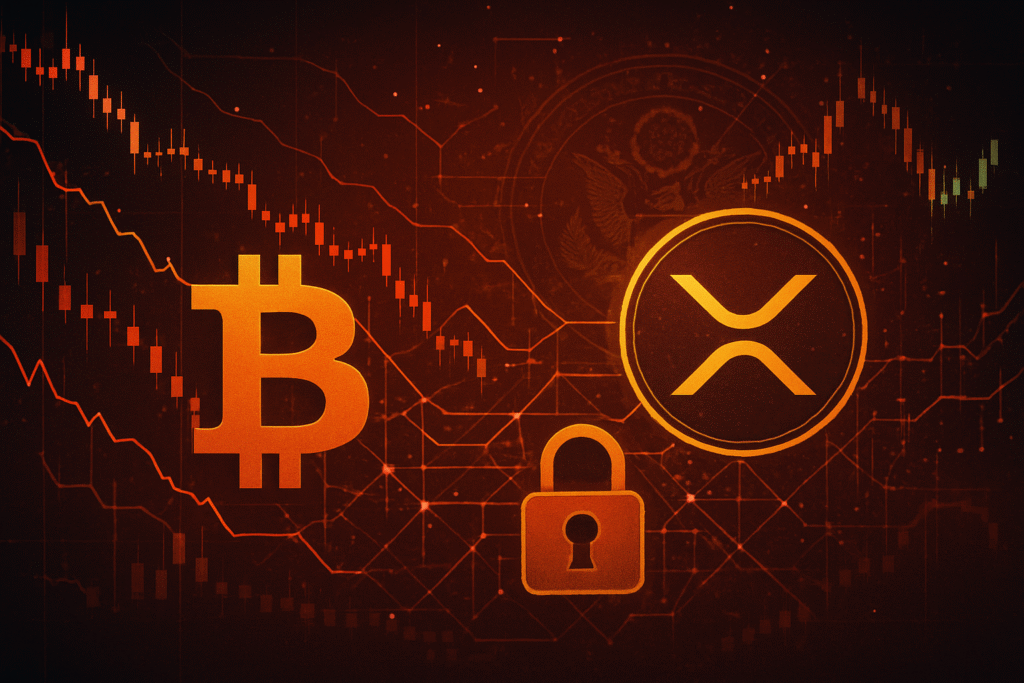
October 21, 2025 – The cryptocurrency world is reeling from the U.S. government's unprecedented seizure of approximately $15 billion in Bitcoin, executed on October 14, 2025. This monumental forfeiture, the largest in the history of the Justice Department, targeted a sophisticated "pig-butchering" syndicate known as the Prince Group, allegedly led by Cambodian national Chen Zhi. The criminal enterprise is accused of orchestrating a global scheme involving large-scale fraud, money laundering, and human trafficking, operating forced-labor camps where victims were coerced into running fraudulent crypto investment schemes.
The staggering 127,271 Bitcoin confiscation has sent shockwaves through the digital asset ecosystem, immediately "shaking" confidence in both Bitcoin (BTC) and XRP. Market participants reacted with apprehension, leading to warnings of short-term volatility and broader impacts on investor trust. While the U.S. Department of Justice (DOJ) publicly announced the seizure, alongside sanctions from the U.S. Treasury Department and the UK Foreign Office against 146 individuals and entities, the event has intensified scrutiny on the security of digital assets and the evolving landscape of government oversight. Crucially, the confiscated Bitcoin is slated for the U.S. Strategic Bitcoin Reserve and Digital Asset Stockpile, a program directed by President Trump's administration in March 2025, rather than immediate liquidation, a policy shift with significant implications.
Market Impact and Price Action
The week following the October 14 seizure witnessed significant turbulence across cryptocurrency markets. Bitcoin (BTC) experienced an immediate price drop, tumbling from highs around $122,500 on October 10 to as low as $104,782 during a broader "flash crash" that erased over $370 billion in value within hours. By October 21, Bitcoin was trading around $108,131, reflecting a 2.77% loss in the preceding 24 hours and extending its 7-day loss to 3.27%. The asset consistently traded below key technical indicators, with the 50-day Exponential Moving Average (EMA) at $113,855 and the 200-day Simple Moving Average (SMA) at $108,026, signaling weakening momentum and growing bearish sentiment. A sustained close below $107,000 was eyed as a potential trigger for a further drop towards $102,000.
XRP also faced considerable volatility, initially losing 15% of its value overnight around October 10 and over 25% in the preceding month, with prices moving from approximately $3.10 to lows near $1.53. However, XRP demonstrated "remarkable resilience" in the aftermath of the seizure. By October 20, it had recovered roughly 7% from its Friday afternoon low, and by October 21, it had surged 13% from Friday's low of $2.18 to an intraday high of $2.48, making it one of the best-performing major cryptocurrencies in that period. Analysts projected XRP could oscillate between $2.08 (support) and $2.33 (resistance), with a breakout above $2.33 potentially signaling a bullish trend towards $3.00.
Trading volumes surged across the board during the October 2025 crash, driven by "massive sell-offs and record liquidations." Bitcoin ETFs recorded $223 million in outflows the week prior to October 21, and long-term holders offloaded approximately 40,000 BTC, contributing to a "supply overhang." For XRP, large holders ("whales") initially sold billions of tokens, yet XRP holdings on controlled exchanges decreased, suggesting a reduction in selling pressure and potential for rapid price appreciation with renewed demand. XRP's decentralized exchanges (DEXes) showed less contagion during the market downturn, and its liquidity remained "pretty solid" with a $5.15 billion 24-hour trading volume.
Historically, U.S. government Bitcoin sales, such as those related to the Silk Road seizures, have often had "little lasting impact on BTC prices" when conducted through public auctions rather than direct exchange sales. The current policy shift to hold seized Bitcoin in a Strategic Bitcoin Reserve, established in March 2025, significantly mitigates the risk of market flooding. This approach, treating Bitcoin as a strategic asset, signals a growing institutional legitimacy for BTC, contrasting with past practices of immediate liquidation. While the market initially reacted with fear and significant price drops, especially for Bitcoin, the resilience shown by XRP and the government's long-term holding strategy suggest that the market is increasingly capable of absorbing such events, distinguishing between targeted enforcement and a systemic threat.
Community and Ecosystem Response
The U.S. government's $15 billion Bitcoin seizure ignited a fervent and complex discussion across the crypto community, particularly on social media platforms like X (formerly Twitter) and Reddit. Initial reactions included speculation from influencers like "The Bitcoin Historian (@pete_rizzo_)" and Exodus (EXOD) wallet CEO JP Richardson, who shared posts suggesting the U.S. government's total Bitcoin holdings had swelled significantly, prompting clarifications on the distinction between seized and held assets. The debate often centered on the implications of such a large accumulation of Bitcoin by a sovereign entity, with some expressing concerns about potential market manipulation if these holdings were ever liquidated, while others viewed the action as a crucial step in legitimizing the crypto space by aggressively combating criminal activity.
Prominent fintech experts, such as Henri Arslanian, highlighted the seizure as a key market catalyst, emphasizing that government wallet movements and potential exchange inflows of seized assets are critical signals for traders to monitor. The broader sentiment, as reflected in crypto news analyses, was a mix of apprehension and cautious optimism. There was widespread recognition of law enforcement's increasing capability to track and recover illicit cryptocurrency, which many saw as a positive development for the long-term credibility of digital assets.
The seizure is expected to have notable effects on related DeFi protocols, NFT projects, and Web3 applications. It is anticipated to "spark significant industry and governmental responses to tighten compliance and mitigate risk impacts," leading to stricter regulatory oversight. This means DeFi protocols, NFT marketplaces, and Web3 applications will likely face increased pressure to implement more robust Know Your Customer (KYC) and Anti-Money Laundering (AML) procedures. On the positive side, the successful recovery of such a substantial sum from "pig butchering" scams could help restore faith among retail investors, potentially encouraging broader participation in legitimate DeFi and Web3 projects. The discussions around the U.S. potentially expanding its "Strategic BTC Reserve" also fueled interpretations of Bitcoin's growing national-level legitimization, influencing long-term institutional perception and adoption across Web3.
In the week following the seizure (October 14-21, 2025), the broader crypto community exhibited a blend of sentiments. While the action against criminals was largely welcomed as a positive step towards cleaning up the industry, concerns lingered among those prioritizing decentralization and privacy regarding the expansion of government control over digital assets. The event intensified focus on the evolving regulatory landscape, underscoring the global push for greater compliance and transparency. Despite the scale of the seizure, reports indicated a degree of market resilience, with analysts believing that while macro-political risks introduce volatility, the fundamental drivers of the bull market remain intact, pointing towards a more volatile but structurally sound market ahead.
What's Next for Crypto
The U.S. government's $15 billion Bitcoin seizure on October 14, 2025, marks a pivotal moment, signaling profound short-term and long-term implications for the cryptocurrency market beyond October 21, 2025. In the immediate future, heightened volatility and a dip in investor confidence are anticipated as the market digests the news and speculates on further regulatory actions. The Crypto Fear & Greed Index could remain in "Extreme Fear," reflecting eroded trust and a temporary slowdown in mainstream adoption as investors re-evaluate risks. However, the targeted nature of the seizure against a major criminal syndicate also reinforces the narrative of governments effectively combating illicit crypto use, a long-term positive for market legitimacy.
Looking further ahead, the long-term implications are primarily centered on accelerated regulatory clarity, the strategic management of government crypto assets, and evolving institutional investment strategies. This massive seizure, combined with legislative developments like the U.S. GENIUS Act for stablecoin regulation and the UK's Cryptoassets Order 2025, underscores a global trajectory towards comprehensive crypto regulation, focusing on consumer protection and AML/CFT. The most significant development is the U.S. Strategic Bitcoin Reserve (SBR), established in March 2025, which dictates that seized Bitcoin will be held as a strategic asset rather than immediately sold. This policy shift, designed to prevent market flooding and stabilize prices, is a powerful endorsement of Bitcoin's long-term value and legitimization, with U.S. government holdings now exceeding 325,000 BTC.
Several catalysts and developments bear watching. Further regulatory actions, including ongoing discussions around the Digital Asset Market Clarity Act (CLARITY Act), could further define asset classifications and establish clearer frameworks. Any shift in the U.S. policy regarding the disposal of seized assets, potentially influenced by future administrations or economic pressures, could lead to large-scale sales, impacting market stability if not carefully managed. Institutional investors will closely monitor government crypto reserve management and new regulations, with increased clarity potentially attracting more institutional capital into regulated products like ETFs. However, overly aggressive government intervention or sustained market uncertainty could lead to hesitation. Geopolitical tensions and cyberattacks on government crypto reserves also present strategic risks that could influence market dynamics.
For crypto projects, strategic considerations include prioritizing compliance with evolving KYC/AML measures, embracing transparency, diversifying offerings, and strengthening custody and legal structures. Investors should emphasize self-custody ("not your keys, not your coins"), adopt robust risk management and diversification strategies, and stay informed on regulatory developments. Possible scenarios range from "Controlled Integration and Stability," where strategic government holding and clear regulations foster institutional confidence and Bitcoin's role as "digital gold," to "Prolonged Uncertainty and Disruption" if regulations become overly restrictive or unmanaged asset sales occur. A "Market Adaptation and Resilience" scenario sees the industry maturing with a focus on compliance and robust security, leading to a more segmented but ultimately more stable market.
Bottom Line
The U.S. government's $15 billion Bitcoin seizure on October 14, 2025, represents a watershed moment for the cryptocurrency ecosystem, with far-reaching implications for investors and enthusiasts alike. The key takeaway is the undeniable escalation of government involvement and oversight in the digital asset space. While the targeted action against a major criminal syndicate is a positive step towards combating illicit activities and potentially restoring retail investor trust, it also underscores that even decentralized assets like Bitcoin are subject to legal jurisdiction and government intervention, particularly when linked to criminal enterprises.
The long-term significance of this event lies in its dual impact on market trust and regulatory evolution. The establishment of the U.S. Strategic Bitcoin Reserve, a policy to hold rather than immediately liquidate seized Bitcoin, is a crucial signal of Bitcoin's increasing recognition as a strategic asset by a major global power. This could contribute to long-term price stability and institutional legitimization, but also raises questions about the concentration of Bitcoin holdings. For XRP, its "remarkable resilience" in the face of market volatility highlights the importance of regulatory clarity and real-world utility in navigating periods of uncertainty.
Ultimately, this seizure accelerates the maturation of the crypto market. While short-term volatility and apprehension are natural responses, the event pushes the industry towards greater compliance, transparency, and robust security measures. For crypto adoption, this could mean a more regulated but ultimately more trustworthy environment, attracting a broader spectrum of institutional and retail investors who prioritize security and regulatory clarity. Investors should closely monitor further regulatory announcements, particularly concerning the management and potential future disposition of government-held crypto assets, and remain vigilant about the macroeconomic environment and geopolitical developments that could impact market sentiment.
This article is for informational purposes only and does not constitute financial or investment advice. Cryptocurrency investments carry significant risk.


















